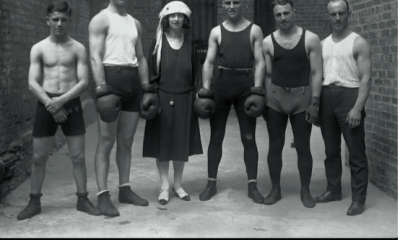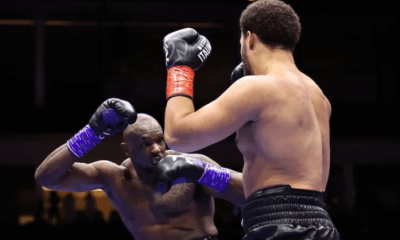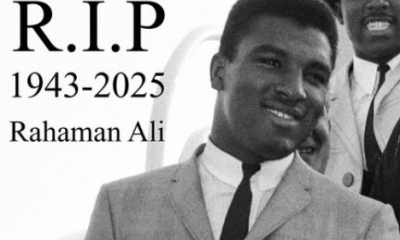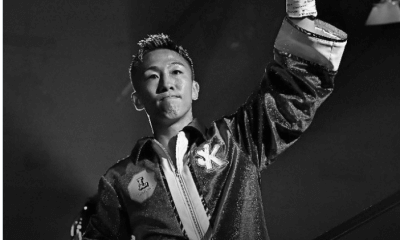Articles of 2010
JOSE CORPAS SPECIAL TO TSS: The Boxing Bailout, Pt II
If the U.S. Government can sponsor a Cash for Clunkers or a Cash for Caulkers program, surely it can sponsor a Bailout for Brawlers.
If boxing were to receive a financial stimulus, how should it use the money?
One option to work towards lessening the amount of severe injuries to pro fighters could be something as simple as a variation of baseball’s pitch count. Implemented amid much controversy, the idea of counting the amount of pitches a pitcher throws was created to protect a pitcher’s arm. The brain should be given at least the same level of consideration in boxing as an arm is given in baseball. Is a punch count to protect a boxer’s head a feasible idea? Not too different from the already well established three-knockdown rule, medical professionals can come up with a set amount of punches that would be considered excessive, and when that amount is reached, an automatic stoppage would occur.
“I don’t like that idea,” says Elbaum, adding, “I don’t like the three knockdown rule either. You can only make so many changes before it becomes something other than boxing.” The pitch count was met with a similar response but it has prevailed and while some lament the lack of complete games by pitchers, it has been credited with prolonging careers and reducing injuries. Granted, the amount of blows that will trigger an automatic stoppage would have to be an amount that will keep boxing from becoming “something other than boxing.” It shouldn’t be a low enough number that fights are ending prematurely, nor should it be a high enough number that the safety of the fighters is compromised. If going down three times, even if they’re flash knockdowns or a fighter taking a knee, constitutes a fighter being overmatched, then getting hit in the head some 250 or so times probably should as well. Dr. Robert Gambrell, a chief ringside physician and member of the Sports Medicine Association of Augusta who has studied and written about boxing safety, says, “The problem with counting head blows may come down to opinion: What is a significant head blow versus a glancing blow.” Concerns over a fight being stopped due to “soft” blows are justified but when a fighter goes down three times, even if unhurt, the fight is halted. Another legitimate concern is that it would encourage head hunting, and it may, but it should also encourage a greater emphasis on defense. The pitch count doesn’t distinguish between soft tosses or 90 mile per hour heat and a punch count shouldn’t either.
The British Medical Association mentions that the minimum force needed to cause brain damage is unknown so there is no way to determine what is a hard punch versus a soft punch. There is now.
Equipment manufacturer Riddell makes football helmets with sensors in the padding that registers and measures the magnitude of a blow. The data is wirelessly transmitted to computers on the sidelines within seconds, where it is monitored by medical personnel. Recipients of severe hits, rated in g-forces, are given immediate medical attention. A similar technology exists for boxing, where nine sensors are placed inside the headgear. It is called the HIT System and is being used by
a research group at Wayne State University under the direction of Dr. Cindy Bir. The HIT System would have to be adapted for use in professional boxing. Senior Research Engineer Jonathan Beckwith states that placing sensors in the gloves has been discussed, although they are not currently pursuing it. Dr. Robert Gambrell says, “The use of sensors in gloves to measure the force of punches was looked at by Dr. Marilyn Boitano a few years ago. The problem is knowing how
much force, or what dose, is dangerous to the brain and nervous system.” If this technology could be used during all future boxing matches, then the data could be pulled from those bouts where a head injury occurs and perhaps a conclusion of how much force is dangerous can be drawn. Any monies received from a bailout could be used towards the research and development of this technology. Technology such as the HIT System or one similar could go a long way towards
giving boxers the medical attention they need especially during the critical “golden hour.” Dr. Gambrell believes “that the use of sensors in headgear and gloves would be great for research and studying the effects and forces involved in boxing. It is another step to use them in competition.” It’s a step we should consider taking.
Unfortunately, in matches where a fighter has suffered head trauma, the extent of the injury is not known until after the fight, which can be several rounds after the injury occurred—a delay with potentially serious consequences. Boxer Rita Figueroa, who is recovering from emergency brain surgery for a broken blood vessel after her November 6, 2009 fight with Kita Watkins, was spared her life by a matter of minutes. “We got her before she slipped into a coma. She would've
progressed to the “severe ultimate scenario of coma and obviously death shortly thereafter” the surgeon, Dr. Sepideh Amin-Hanjani said to the L.A. Times. “Let’s expedite the care, get the fighter out of there, get him to the hospital, get him checked,” Figueroa told the Chicago Tribune. The use of sensors could alert medical staff immediately after a blow of potentially damaging force has landed and physicians could tend to the fighter on the spot rather than wait until a fighter has collapsed or has headaches so severe that they can’t even sign for their check, which is what happened to Rita Figueroa.
“I was already on the stretcher when the doctor came back” she said later. The doctor was ringside for the next bout when Rita was in back unable to sign for her check. To make matters worse, the EMS workers were told not to bring her to the hospital just yet because the next bout had started and no fights can take place without an ambulance present. Her handlers insisted, saving her life in the process. She was fortunate there was an ambulance there. Jacquie Richardson says she and Alex Ramos attended a fight card where the promoter told her that the ambulance was there for the fans—that a limo was provided to take any injured boxer to the hospital.
Thankfully, the majority of matches take place under the best possible medical supervision. They are staffed with ringside physicians and personnel who have prevented and done all that they could to prevent many serious injuries. Dr. Gambrell states, “ We currently monitor the effect of the head blows by having experienced observers, physicians at ringside and the referee, who have the power to stop the fight at anytime the athlete appears to be impaired.” Unfortunately a fighter may be impaired and not look it. Francisco “Paco” Rodriguez died last November of brain injuries suffered during a match with Teon Kennedy in Philadelphia. Rodriguez was “wobbled twice and on the verge of not making it” past the first round according to the Philadelphia Daily News. He was given a standing eight count by the referee in the first round and appeared to recover, lasting until 1:52 of the tenth round. The paper reported that ringside physician Jonathan Levyn checked in on Rodriguez “several times” and saw “no evidence that the fighter was in particular distress.” Dr. Levyn was quoted as saying, “I've replayed it over and over in my mind – the fight itself, the time between rounds. He was coherent. He answered all my questions – simple questions like, 'Where are you? What's your name?' And his eyes were reactive. It seemed like he was OK.” The British Medical Association maintains that the equipment present at boxing matches simply isn’t enough. In the case of Michael Watson, who suffered damage during a 1991 match with Chris Eubank, the boxer had to be ventilated and was administered drugs to reduce the swelling. “This kind of life support treatment is the province of anesthetists, a specialty in which ringside doctors often lack specialist training,” the BMA concluded.
If we can’t provide increased life support, then perhaps the use of sensors or even the implementation of a punch count could help. Johnny Bos says if referees, corner men, and ringside physicians do their jobs, that should be enough. “When a fighter has lost his competitive edge and is being hammered with clean shots, the fight should be stopped,” he said. But Bos doesn’t dismiss the idea of sensors or a punch count because he acknowledges a shortage of experienced professionals in the sport. “It’s a trickledown effect,” he says. “In 2009 we had about 600 shows in America.” Compare that amount to the nearly 2000 shows held during 1950, according to the website boxrec.com. “Not only are there fewer shows but most of the fights are just showcase fights,” continues Bos, “where one guy is clobbering the other, and no one learns a thing. The winner doesn’t learn a thing, the corner men don’t learn a thing, and the judges and referees don’t learn a thing because they’re not watching real fights. They’re watching mismatches.”
It’s a trend others see too. Elbaum laments that “there are a lot of trainers around today but few teachers.” Craft and strategy is disappearing, agrees Bos, wondering how many trainers today can teach a fighter how to roll with a punch. This could be because fewer and fewer trainers are able to make a living off of training. The Brazilian sport Luta Livre, which was one of the most popular forms of wrestling in Brazil until recently, is believed by many to have dwindled in popularity for precisely that reason. Contributing to the problem is the lack of job security for many. A lot of trainers are afraid of getting fired. So they sometimes become “yes men,” says Bos. “But at least they’re under contract to get paid. Do you know that many cut men, booking agents, and matchmakers are working without the protection of a contract? Managers, promoters, trainers, their contracts are on file with the commission. At least they can sue if they don’t get paid. What about the others?”
Elbaum says if there is a bailout it should go to promoters: “Medicals and safety reforms are all very important. But before you give any money to the doctors or scientists, it should go to the promoters. Boxing needs more matches. Without fights there is no boxing.” Elbaum, who has been promoting boxing since black and white television, says it “should go to the promoters to keep the small club shows going. If you could designate 10 cites and fund six to eight shows per year for two years, well, that would go a long way toward developing talent.” If cities like Detroit, where the unemployment rate is just under 30 percent, were to have a steady influx of promotions, it could boost both their local economy and help create jobs, as well as develop the careers of boxing professionals.
A Bailout for Brawlers would help set the wheels in motion and then some of the other areas could be addressed. With more shows comes more practice. Then, maybe, referees would all count at the same speed. Then, maybe, there would be less nights where judges scored a different fight than the ones almost everyone else saw. Then, maybe, we can implement instant replay. Then, maybe, we can have better drug testing and no one would have to wonder if anyone is cheating or not. Then, maybe, testing can be done not just for steroids but for human growth hormones too, tests like the one used to catch rugby player Terry Newton. Then, maybe, all the accusations would finally stop—like Tommy Hearns accusing Ray Leonard of being “on steroids or something” twenty years ago and today, other fighters being accused of similar things. Then, maybe, big fights like Floyd Mayweather Jr. versus Manny Pacquiao can take place. Then, maybe, promoters can start promoting boxing-not boxers. Then, maybe, promoters can find new and imaginative ways to promote the sport rather than depend on network television, especially since, according to Time magazine, the amount of viewers tuning in to network TV has dropped from 43% to 27% since 1995. Then, maybe, we can have better undercard bouts on the pay per views we order. With the increased amount of fights, we can tack on that extra dollar to every ticket and pay per view and use the extra revenue to establish a national pension, one that boxers and boxing professionals can contribute to as well. Then again, if we tacked on that dollar now, maybe we won’t need a bailout.
-

 Featured Articles3 weeks ago
Featured Articles3 weeks agoThe Hauser Report: Cinematic and Literary Notes
-

 Featured Articles4 weeks ago
Featured Articles4 weeks agoOscar Duarte and Regis Prograis Prevail on an Action-Packed Fight Card in Chicago
-

 Book Review3 weeks ago
Book Review3 weeks agoMark Kriegel’s New Book About Mike Tyson is a Must-Read
-

 Featured Articles1 week ago
Featured Articles1 week agoThe Hauser Report: Debunking Two Myths and Other Notes
-

 Featured Articles2 weeks ago
Featured Articles2 weeks agoMoses Itauma Continues his Rapid Rise; Steamrolls Dillian Whyte in Riyadh
-

 Featured Articles4 weeks ago
Featured Articles4 weeks agoRahaman Ali (1943-2025)
-

 Featured Articles4 weeks ago
Featured Articles4 weeks agoTop Rank Boxing is in Limbo, but that Hasn’t Benched Robert Garcia’s Up-and-Comers
-

 Featured Articles3 weeks ago
Featured Articles3 weeks agoKotari and Urakawa – Two Fatalities on the Same Card in Japan: Boxing’s Darkest Day














